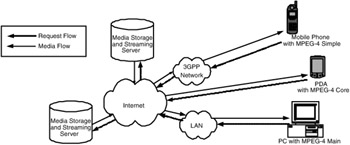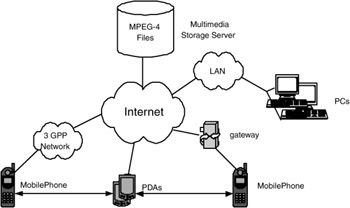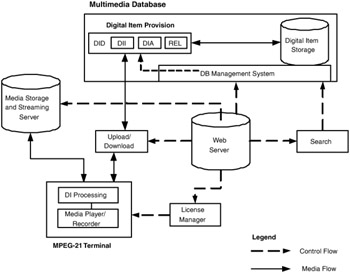Chapter 5: Distributed Multimedia Database Systems
|
| < Day Day Up > |
|
This chapter describes the architecture and components of distributed Multimedia Database Systems (MMDBMS) responsible for delivering, streaming, and receiving multimedia data, and the effect of MPEG-21 on the implementation of the components is described in particular.
We will start by illustrating different distributed MMDBMS architectures in use; namely, the client-server (C-S), peer-to-peer, and an MPEG-21-based architecture. The remaining parts of this chapter are mainly the descriptions of the different components: multimedia storage servers, network and client considerations, and finally, adaptation issues.
5.1 Architectural Considerations
5.1.1 C-S System
Many distributed MMDBMSs [1], [2] for pull applications rely on C-S architectures. In this scenario, client applications request multimedia data from the server, which are then processed locally. Obviously, this architecture minimizes the degree of parallel processing that can occur because of the synchronous nature of the request function. [3]
Furthermore, it is a common experience that pure C-S systems do not scale well with respect to the number of users, the heterogeneity of the terminals employed, and the size of the data requested. Exhibits 5.1 and 5.2 give an example in which two media storage and streaming servers are available for media requests. The three terminals here support, because of their hardware characteristics, three different coding standards—MPEG-4 Simple, Core, and Complex—and different display capabilities. Moreover, the network between the server and the terminal differs, as the personal computer (PC) in the example has a direct and good connection via LAN (local area network) to the Internet and the mobile phone must go over a mobile network.
Exhibit 5.1: Client-server-based multimedia system.

Exhibit 5.2: Client-server-based multimedia system with different profiles.

All terminals in Exhibit 5.1 wish to be provided with rich multimedia access. A simple C-S system would scale poorly in this context, because the server proposes only a video encoded using the MPEG-4 main profile, and as a consequence, the mobile phone and the personal digital assistant (PDA) would not receive a stream at all. Thus, the mobile phone and the PDA, when they request the content desired, will receive a "Cannot Play" answer, although the PC will receive fine. The situation is shown in Exhibit 5.2.
A more scalable architecture would feature interdependent servers of variable availability and reliability, owned by competing organizations (peer-to-peer architecture, see below). Moreover, it would manage content encoded in different formats to be consumed by heterogeneous terminals. Finally, for dynamic changes in the delivery situation (e.g., when the content is streamed through the Internet), the server will provide information to steer dynamic adaptation.
We introduced a scalable video server architecture [4], [5] that allows the migration of modules to a proxy or client. In such an architecture, which relies on competition and on cooperation, mobile agents are also a possible paradigm for a more flexible usage.
5.1.2 Peer-to-Peer System
To allow greater flexibility, multimedia systems evolve from pure C-S system to peer-to-peer (P2P) systems with the notion of a "user," which is defined in MPEG-21 as an entity to consume and to produce digital multimedia items. [6], [7], [8] A P2P architecture is shown as in Exhibit 5.3, where portable devices with various capabilities send and transfer multimedia content from one device to another. Exhibit 5.3 shows a PDA user, a mobile phone user, and PC users consuming content from the multimedia storage server but also communicating with each other, including making phone calls, sending e-mail, images, music, and videos to the other, although the terminal capability is quite different from PDAs to mobile phones or PCs. Such a system must provide peer-to-peer services in the form of, for instance, operators, which may have the following functions:
Exhibit 5.3: Peer-to-peer-based multimedia system.

-
To hold the content from the creation to the delivery
-
To check the capability of the other peer party and see whether it can process the multimedia data before delivering
-
To create metadata (e.g., in the form of a MPEG-21 Digital Item [DI]) to describe content received from the users
Many technical challenges arise from the architecture shown in Exhibit 5.3. They concern mainly the realization of generic information communication between peers. A set of open peer-to-peer protocols that allow any connected device on the network to communicate and collaborate in a peer-to-peer manner has to be defined. All the negotiation messages will sit on top of the generic peer-to-peer communication protocols that are uplayers of physical network protocols; for instance, the CC-PP exchange protocol based on HTTP Extension Framework by the W3C[9] or the JXTA v1.0 Protocols Specification, by Sun Microsystems.[10]
In addition, the protocol considerations communication paradigm has to be reconsidered. Mobile agents are an important paradigm in a peer-to-peer multimedia environment. Mobile agents are autonomous, that is, they have their own goals and can negotiate and compete with other agents. They are mobile, so that they can search for a better environment, and are local, so that they may "own" their own data. The great advantage of a mobile agent is that it is simultaneously a client and a server. This obviously fits well with the idea of peers. Moreover, mobile agents make better use of communication bandwidth and protect the privacy of the community, operating on a need-to-know basis.
Natural applications in distributed MMDBMSs are multiuser applications, such as video conferencing, network management, and distributed search. Therefore, several works recently attempted to integrate mobile agent technology into distributed MMDBMSs. The main issue is actually a more efficient quality of service (QoS) negotiation. [11], [12] For instance, Manvi and Venkataram [13] propose a mobile agent-based QoS management system that provides means for efficient agent-based bandwidth negotiation. The idea of mobile agents in distributed multimedia systems can be extended to database functionality, such as content-based retrieval, as well.
In this context, one attempt to be mentioned here is our mobile agent system, which was developed on top of the multimedia extension of Oracle 9i that allows the execution of personal multimedia-searching algorithms in the core of the Oracle database. [14] The system uses the JServer functionality of Oracle 9i, including its CORBA services, which are provided by a VisiBroker CORBA ORB. This distributed implementation allows an agent, during its visits to different DBMSs, to learn from the results of previous visits; for example, an agent trying to find the most similar face to a reference one in a distributed face database can revert in each visit to the previously best match, stored in the agent.
5.1.3 MPEG-21-Based Architecture
A possible architecture for a Web-based distributed MMDBMS relying on MPEG-21 is depicted in Exhibit 5.4. It consists of the following main components:
-
The Multimedia Database holds a collection of MPEG-21 DIs. The DID may contain DI identification(s) for describing the item, DI adaptation(s) for describing its quality of service characteristics and Rights Expression Language (REL) descriptor(s) for describing its usage rights. The provision module of the database is responsible for aggregating the different descriptors available. The resource described is either included in the DID or the DID contains a reference to the resource. Remember that this does not exclude MPEG-7, which may be one descriptor of a DI.
-
The Web server is the front end for all users to the framework providers. It serves several needs, including the following:
Searching for items in the database
Uploading and downloading DIs
Purchasing licenses to contents and trading with them
Controlling the execution of the media streaming
-
The MPEG-21 terminals are where users consume and create DIs for the use in the distributed system.
Exhibit 5.4: Peer-to-peer-based multimedia system relying on MPEG-21.

The system is Web based, which means that DIs may be searched, uploaded, and so forth by Web applications. To interface with the database, middle tiers to the database have to be employed [15] (not shown in Exhibit 5.4). This naturally leads to the specification of a multimedia middleware. The middleware implements complex services; for instance, looking up available services that match a user's service description. There are few works considering how to design a multimedia middleware; for more information, see Chapter 6.
A media streamer is a unit that streams content to a user for immediate consumption. It can stream on a one-to-one connection, as in on-demand (pull) applications, or it can broadcast (push). In both cases, resources will usually be protected, and only licensed users can play it. The REL descriptions are matched against the user descriptors, and if they match, the user may play the resource. In some cases, the DIs are available to the user before the resource is streamed. In other cases, the DIs are delivered together with the resource.
The MPEG-21 terminal enables the user to consume the content delivered in the form of a DI. It could be a Web browser application, a media player, or potentially a media recorder. The terminal contains software to upload or download content, buy or sell licenses, activate the on-demand media streamer, or tune into a broadcast session.
In a peer-to-peer manner, the terminal may create DIs, too. For instance, the user creates the resource with available media recorder and then generates descriptions for the resource. These descriptions include the identification in the form of the DI Identification, information for adaptation engines in the form of DI adaptation, and the rights associated to the resource in the form of a REL description. The resource and the descriptions are bundled in the DID and are uploaded to the Web server for further use in the system; for example, to be stored in the database or delivered directly to another user.
5.1.4 Roadmap of This Chapter
The following sections detail the different components of a distributed multimedia database system and how they are supposed to work together for an end-to-end multimedia delivery.
The first component described is the video server and streamer (Section 5.1). It may be coupled more or less strongly with the database. It is clear that a stronger connection to the database lets the server be more metadata aware, with the consequence of a considerable performance and functionality improvement in the admission control and the buffer management. Section 5.2 is dedicated to multimedia communication. It includes a discussion of communication protocols (e.g., reservation-based and QoS supporting protocols) and secure and reliable communication. Section 5.3 introduces client-design issues, mainly on hardware and software requirements and implementations. Section 5.4 discusses content adaptation[16] and presents a comprehensive adaptation architecture. Finally, Section 5.5 summarizes the main concepts introduced and points to future developments.
[1]de Vries, A.P., van Doorn, M.G.L.M., Blanken, H.M., and Apers, P.M.G., The MIRROR MMDBMS architecture, in Proceedings of the International Conference on Very Large Databases, Edinburgh, 1999, pp. 758–761.
[2]Oria, V., Özsu, M.T., Iglinski, P., Lin, S., and Ya, B., DISIMA: a distributed and interoperable image database system, in Proceedings of the ACM SIGMOD International Conference of Management of Data, Dallas, May 2000, p. 600.
[3]Mühlhäuser, M. and Gecsei, J., Services, frameworks, and paradigms for distributed multimedia applications, IEEE MultiMedia, 3, 48–61, 1996.
[4]Böszörményi, L., Stary, C., Kosch, H., and Becker, C., Distributed multimedia object/component systems (DMMOS'2001), in Workshop Reader of the 15th European Conference for Object-Oriented Programming, LNCS 2323, Budapest, June 2001, Springer-Verlag, New York, pp. 7–29.
[5]Goldschmidt, B., Tusch, R., and Böszörmenyi, L., A mobile agent-based infrastructure for an adaptive multimedia server, in Proceedings of the International Conference on Distributed and Parallel Systems DAPSYS'2002, Linz, September–October 2002, pp. 141–148.
[6]Chan, S. and Tobagi, F., Distributed servers architecture for networked video services, IEEE Trans. Networking, 9, 125–136, 2001.
[7]Xu, D., Hefeeda, M., Hambrush, S., and Bhargava, B., On peer-to-peer media streaming, in Proceedings of IEEE International Conference on Distributed Computing Systems (ICDCS'02), Vienna, July 2002, pp. 363–373.
[8]Nguyen, T. and Zakhor, A., Distributed video streaming over Internet, SPIE Conference on Multimedia Computing and Networking 2002 (MMCN 2002), San Jose, January 2002.
[9]http://www.w3.org/Mobile/CCPP/.
[10]http://www.jxta.org/.
[11]Guedes, L.A., Oliveres, P.G., Paina, L.F., and Cordozo, E., An agent based approach for supporting quality of service, Comput. Comm., 21, 1269–1278, 1998.
[12]Manvi, S. and Venkataram, P., QoS management by mobile agents in multimedia communication, in Proceedings of the International DEXA 2000 Workshops, Greenwich, London, September 2000, IEEE CS Press, pp. 407–411.
[13]Manvi, S. and Venkataram, P., QoS management by mobile agents in multimedia communication, in Proceedings of the International DEXA 2000 Workshops, Greenwich, London, September 2000, IEEE CS Press, pp. 407–411.
[14]Kosch, H., Döller, M., and Böszörményi, L., Content-based indexing and retrieval supported by mobile agent technology, in 2nd International Workshop on Multimedia Databases and Image Communications (MDIC), Amalfi, September 2001, pp. 152–166.
[15]Özsu, M.T. and Valdueriez, P., Principles of Distributed Database Systems, Prentice-Hall, Englewood Cliffs, NJ, 1999.
[16]Throughout this chapter we will use the term content adaptation to describe the adaptation of the media content to an alternative form to meet current usage and resource constraints. MPEG-21 prefers the term resource instead of content to avoid the mismatch between content as semantic content and media content. However, most related papers use the term media content in this context, and to avoid confusion with respect to these papers, we adopted content.
|
| < Day Day Up > |
|
EAN: 2147483647
Pages: 77